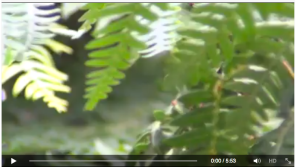My film Watching (2014) is a meditation on a number of things. The subject is a Radar station in North Norfolk on the outskirts of the village where my maternal great grandmother was born. There she had a daughter out of wedlock who her parents brought up while my great grandmother was packed off to work in service. Her daughter (Hilda) died aged nine while she was away.
Radar is an object-detection system that uses radio waves to determine the range, altitude, direction, or speed of objects. It can be used to detect aircraft, ships, spacecraft, guided missiles, motor vehicles, weather formations, and terrain. The radar dish or antenna transmits pulses of radio waves or microwaves that bounce off any object in their path. The object returns a tiny part of the wave’s energy to a dish or antenna that is usually located at the same site as the transmitter.
Radar was secretly developed by several nations before and during World War II. The United States Navy coined the term RADAR in 1940 as an acronym for RAdio Detection And Ranging. The term radar has since entered English and other languages as a common noun, losing all capitalization.
The modern uses of radar are highly diverse, including air traffic control, radar astronomy, air-defence systems, antimissile systems; marine radars to locate landmarks and other ships; aircraft anti-collision systems; ocean surveillance systems, outer space surveillance and rendezvous systems; meteorological precipitation monitoring; altimetry and flight control systems; guided missile target locating systems; and ground-penetrating radar for geological observations. High tech radar systems are associated with digital signal processing and are capable of extracting useful information from very high noise levels. (Wikipedia)
The film tries to show the watcher being watched and does this from various positions around the facility using these points of view to add context and other material to problematize the subject. The film is not about Radar, but things coming back and the implications of surveillance more generally and the impact of surveillance on the thing doing the surveying or watching.
The film tries to anchor the act of looking in the land and within nature firstly then moves on to look at the imposition of agriculture and then looks at the watcher from a hung heap. Then the point of view changes to that of the danger and threat of the act of observing. It focuses on the barrier, of what is inside and what is outside, of containment and echoes the watchtowers of Concentration Camps.
Lastly, the film ends with a contemplation of the loneliness of the watcher. The sentinel standing watch waiting but unarmed. The sentinel also has medical implications in the body’s defence mechanism and the reference alludes to the threat of disease brought though the skies like the threat of the Ebola virus following the recent outbreaks in West Africa.
A multi-layered soundtrack accompanies the film. It comprises sounds of the radar machine humming and a song played by myself on the accordion. The song is a Sephardic lament, a tune written by displaced people with haunting echoes, highlights the intolerance to Jewish people in times gone by and now and the threat and vulnerability that refugees experience when they are ejected or flee from their homes and have to try and forge a new life somewhere else from scratch.
The film point of view also raises questions of its own, shots moving from ground level moving upwards which on the one hand as I said, suggests anchoring but also hints at a lower position of the observer looking at the watcher – i.e. an unequal power relationship.
The film also has echoes of Russian Constructivism in the aesthetic of the zoom shots and of heroic worker imagery of later soviet realist images with the shots of the plough. The work is meant to be multi-layered so as not to give one particular reading. Rather it is hoped it will work on an emotional level with sound and POV building a dialogue that enables multiple readings and none.
Finally, the work was an attempt to make something that was forgettable. But the subject is also about the forgotten or the unseen that watches or observes and the refracted traces of objects, forms or movement. The act of movement leaves little trace, we have points of departure and arrival, but the transition is often forgotten or regarded as unimportant, except perhaps to the watcher or observer, and so in life.

